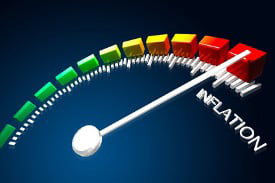According to Federal Reserve chairman Jerome Powell, disinflation is now taking hold.
Yes, the very same person who had to walk back his ridiculous pronouncements in 2021 and 2022 that inflation was "transitory" now wants us to believe that inflation is in the process of steadily declining.
Powell delivered a quarter-point rate hike on Wednesday. He also delivered remarks widely interpreted by markets as dovish. He suggested the Fed was close to declaring victory over inflation.
"It is gratifying to see the disinflationary process now getting underway," Powell said.
 He forecasted "slower growth, some softening in labor market conditions, and inflation moving down steadily, but not quickly."
He forecasted "slower growth, some softening in labor market conditions, and inflation moving down steadily, but not quickly."
The Fed's focus is shifting from fighting inflation to trying to engineer a soft landing for the economy. As a consequence, expectations are growing for central bankers to end their tightening campaign soon and possibly pivot to rate cuts later in the year.
That could be a formula for further declines in the Federal Reserve note “dollar.” The Dollar Index dipped to a 9-month low on Wednesday. (We put the word dollar in quotations because a true dollar is defined as 0.7734375 troy ounces of silver.)
Gold, meanwhile, rose to a 9-month high of $1,950/oz.
Precious metals markets certainly aren't reflecting disinflation. Quite the opposite.
And government deficit spending, one of the primary drivers of new currency creation, isn't about to start disinflating. Although technically the government's borrowing capacity has run into a statutory ceiling, bureaucratic work-arounds by the Treasury Department ensure Uncle Sam won't have to tighten his belt.
President Joe Biden met with House GOP leader Kevin McCarthy this week to discuss formally raising the debt limit. No deal has been reached yet.
Some in the mainstream media are hyping the debt showdown as potentially triggering a catastrophic default.
But the bond market, which possesses much more accumulated wisdom than journalists and pundits, is currently reflecting a 0% chance of default and a 100% chance that the government will borrow more currency into existence in order to pay its bills.
The bottom line is that there will be no disinflation of the currency supply.
Jerome Powell may be partially correct, however, in forecasting price pressures to ease in certain areas of the economy as it softens. We are currently seeing home prices and car prices come down. We could also see downside pressure come to bear on economically sensitive commodities.
Precious metals markets often move in the opposite direction of the economic cycle and of conventional financial assets.
Gold and silver prices lagged as broader inflation pressures hit the economy in 2021 and into the first half of 2022.
The metals are now showing signs of outperforming. That outperformance could persist as the Federal Reserve continues to shift its policy stance away from inflation fighting and toward bailing the economy out of recession.

